4416
Beginners Guide to Augmented Reality Fashion
24 Sep, 2020
14 min read
4416
24 Sep, 2020
14 min read
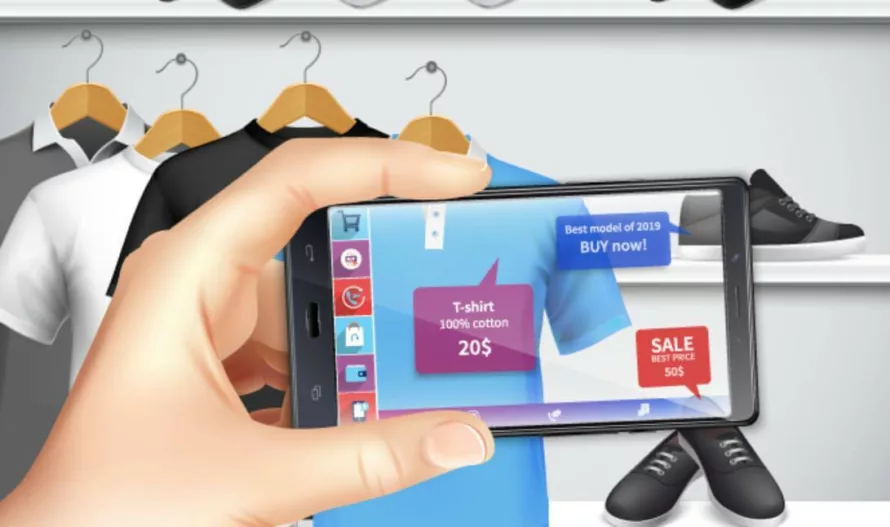
The global fashion industry suffers profit decline. Company bankruptcies. Closing stores. Empty malls. Canceled orders.
This is what you are likely to read if you check fashion news of the last couple of months.
So, what do you do as an entrepreneur?
As an entrepreneur, failure is an everyday activity. It’s how you manage it that determines your success. – Beth Doane, Raintees Founder
The pandemic has paved the way for digital transformation. Therefore, many businesses are starting to rethink their models digitally. Posting digitally is one of the new trends brand owners use, especially they use Facebook Post Scheduler to make their path easy in this digital world. They are also beginning to use AR technology to reimagine the shopping experience. We think that the old rulebook to interact with the world no longer applies. Fashion brands must evolve, and AR has the potential to help you.
Therefore, we are here to share our insights on how augmented reality fashion can change your business. In this guide, we will also discuss the roadmap of incorporating augmented reality for clothing business.
What this post covers:
Fashion is one of the biggest yet most challenging industries. Global economic uncertainty and changing trends are what affect this industry the most. Financial reports published by renowned fashion brands indicate how the pandemic has disrupted the industry. For instance, the sales growth of H&M was significantly lower in the 1st half of 2020.
In the fashion industry, the biggest challenges come from
(a) changing customer expectations
(b) competitors who have embraced digital solutions.
In such a scenario, how do you remain relevant and successful?
The solution lies in embracing digital transformation. It would help if you were quick in creating new experiences for customers. It’s possible by offering new products, involving new channels, etc. With augmented reality, it’s possible to remodel your business model and overcome these challenges.
Let’s examine it more carefully.
Augmented reality, one of the biggest technology trends, is an enhanced version of the real physical world using sensory stimuli. The early adopters of AR have developed technologies to improve the customer shopping experience.
From incorporating this technology into apps, and stores, to using it as a marketing tool, businesses are beginning to see tangible results. In this section, we will focus on how augmented reality fashion works. But since it’s always a good thing to first get an overview of the market, let’s see what the statistics say.
In an interview with Vogue, Apple CEO Tim Cook stated that Augmented Reality is set to modernize shopping experiences and fashion runways. “I don’t think there is any sector or industry that will be untouched by AR,” Cook said.
Have an idea of an AR app for your business? Let us help with all the things you will need.
To reach out to tech-savvy customers, brands have dabbled into Augmented Reality technology by creating immersive experiences. Let’s have a look at some examples.
With limited access to in-store experiences, fashion businesses are looking for alternatives to demo products in real-time. With augmented reality, you can offer virtual try-on experiences to your customers. This will give them an accurate idea of the look, size, and feel of the product.
For instance, Sephora’s Virtual Artist app encourages users to try-on beauty products using the app. Using the facial recognition technique, the app scans the user’s face to detect eyes, lips, and cheeks. Then the user places the product to find the perfect shade. There’s an instant click to buy function that allows the user to purchase the products within the app.
Since make-up involves an extensive library of colors, it can go very well with the virtual try-on technology.
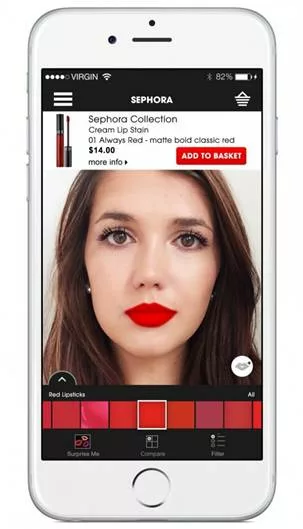
Another space where the try-on experience is popular is accessories. Let’s take, for example, sunglasses. The customer can select their favorite frame and color and then virtually try-on the eyewear. Topology Eyewear is an AR app offering custom-fit glasses from a 3D scan of your face. The app first takes a video selfie to capture facial measurements and then creates custom-made glasses. The user can try on any number of glasses and adjust the lenses for height and width.
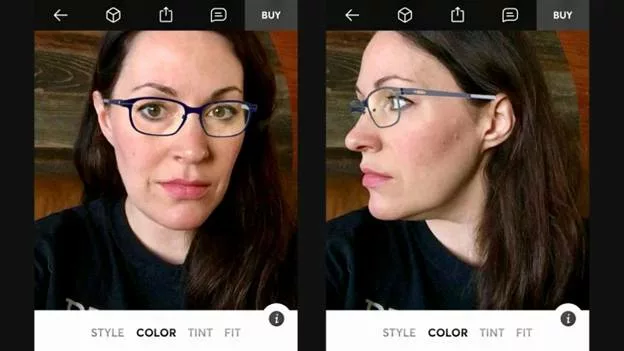
Product fitting is a major challenge that most brands are facing. Augmented reality try on clothes seems to be working well. That’s why, to reduce customer dissatisfaction and boost business operations, businesses implement virtual fitting room (VRF) technology. VRF technology lets customers try garments, shoes, etc., on a 3D avatar without wearing the product. This way augmented reality for clothing creates a personalized and engaging experience that benefits both customers and the brand.
GAP was one of the first apparel retailers experimenting with augmented reality clothing. GAP’s Dressing Room App allows users to try out a dress on a virtual mirror. As you can see in the image, the app lets you enter height, weight, and body shape to generate a digital avatar. The interface uses the device’s camera to scan the user’s body and render digital garments on the person. Customers can move their self-made avatar around so they can check themselves out from all angles in their new outfits.
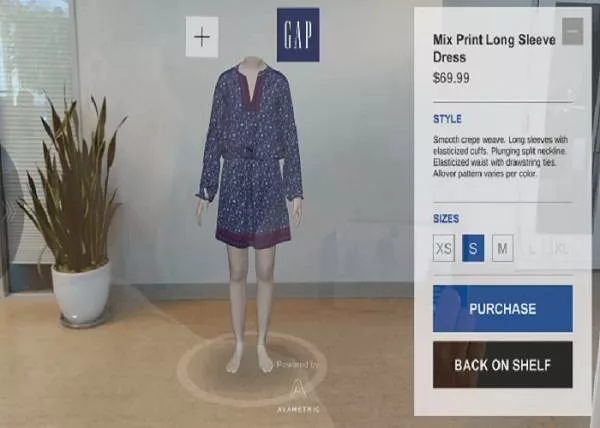
Even footwear brands like Adidas are utilizing augmented reality to improve customer experience. Adidas has a try-on feature in its app that enables customers to virtually try-on different models.
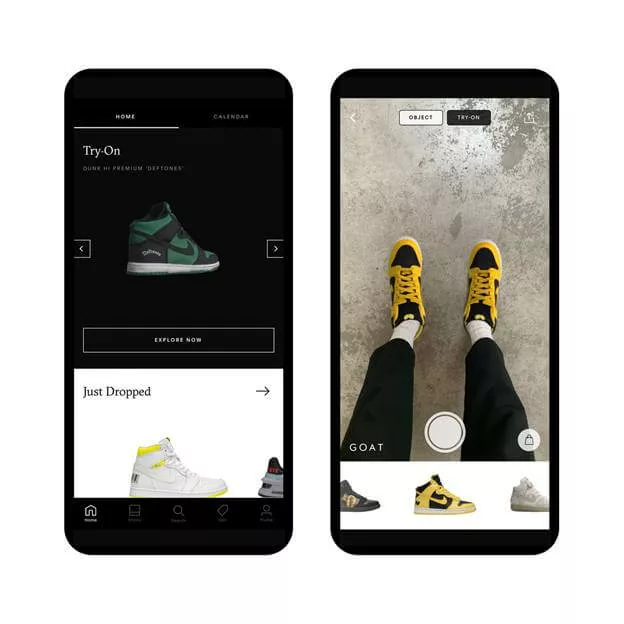
The global virtual fitting room market size in 2019 was 2.44 Billion USD, which might reach USD 10.00 billion by 2027.
Benefits of augmented reality clothing for your business:
No measuring tapes, no awkward body scanners. You can now get a perfectly fitted out with the precision of the AR technology. A virtual tailor utilized machine learning technologies to provide highly accurate body measurement for customers.
One popular apparel company using this is Fit Freedom. Fit Freedom is a body measurement application that simplifies the online apparel shopping experience. The application captures the user’s measurements, translates the measurement data across multiple product lines, and creates custom-fitting garments. Thus, it provides quick, simple body measurements, creating a 3D fit model that recommends the shopper’s size across the platform’s available retailers.
A smart mirror is a popular use case for augmented reality clothing. It allows users to try a garment on the virtual models displayed in the mirror. The mirror uses AR and Radio Frequency Identification that serves the purpose of a fitting room. When the user brings a garment in front of the mirror, it scans and stores the image of the same. The mirror then scans the user to create a virtual model wearing that scanned piece of clothing. The user also gets a 360 view to see the outfit from different angles.
Fashion retailer Zara changed the shopping game with the Zara AR App. After downloading the augmented reality clothing app, customers can point their phones at the shop window, via in-store podiums, or dedicated images at zara.com, and models come to life for seven- to twelve-second sequences giving a realistic experience. You can order the looks shown either online or from the store. The app even features a tool for sharing the experience on social media with your friends. This helps to increase customer engagement and creates brand awareness.
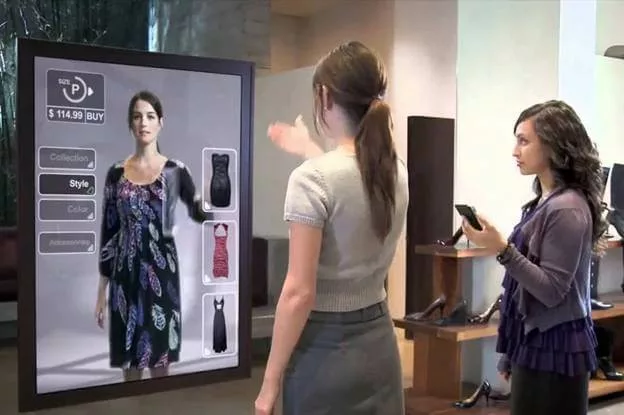
Top retail brands like Topshop, Ralph & Lauren, H&M, Zara, Burberry, and others are using augmented reality for clothing to improve customer engagement, reduce the discomfort of traditional trial rooms, deliver a personalized shopping experience, and ultimately increase profit and sales.
Do you have an idea to incorporate augmented reality in fashion business? We can help you build a feature-rich AR app.
We hope that with these examples, you have a clear idea of some of the most common ways to utilize AR in fashion. So, now, let’s talk about forming a clear strategy. What are the options you have to implement this technology?
There are two ways your offline store can benefit by implementing augmented reality for fashion:
It is possible to employ the AR technology to position the user location. You can integrate AR markers in your store interior and help customers with guided store navigation which helps them reach their desired product.
If you have an AR app, the user can use the navigation session, which will display the path to the selected product. This way, by bridging the gap between the online and in-store experience, you give your customers the convenience to find what they want and encourage them to return in the future.
With social distancing becoming a new norm, your customers will hesitate to try products, especially garments in real-time. Having digital screens can be a game-changer for your fashion store. With display screens and virtual trial rooms, your customers can visualize themselves in front of a mirror/screen and decide on what fits them without physically the product.
This type of engaging shopping experience will encourage users to contact your brand in the future. And there’s no doubt that this unique approach makes people notice you.
Remember that the key to success is offering a personalized experience. A mobile app can easily do it for you. Whether it’s helping a customer choose the best product or offering a customized product, an AR app can do it all.
If you are selling products online, why not allow your customers to try out products virtually. With augmented reality fashion, the possibilities are endless. Your customers can create their virtual avatars, try-on products to check size, height, color, etc. This will give them a clear idea and significantly eliminate order returns.
Furthermore, you can utilize AR in your marketing campaigns too. For instance, if you’re a cosmetics brand, you can create an AR filter for social media and encourage users to try different lip color shades. You can boost engagement by encouraging people to tag your brand in their pictures.
AR is not a mysterious or difficult technology. With the right strategy and development approach, you can do wonders. As discussed earlier, there are several ways to implement this technology. Display screens, 3D models, try-on features, interactive chatbots, etc.
If you are planning to create an augmented reality fashion app, we can help you explore this space with remarkable accuracy.
Even after the development of advanced applications, there are certain challenges with augmented reality. Let’s find out what they are.
Augmented reality fashion development involves the latest technologies and frameworks and a solid grip on creating 3D images. Here are some points to consider when planning to get an AR app developed.
An SDK kit is the fundamental infrastructure of your application. In case you had this thought at the beginning that how can you infuse digital content into the real world, then SDK is the answer. Max, ARToolKit, Apple ARKit, Vuforia are some well-known SDKs.
We think this is a crucial choice because it’s a software development kit responsible for several components like scene recognition and AR tracking. We recommend ARCore for Android and ARKit for iOS. Their functionalities like motion tracking, light estimation, environment tracking, etc., best suit AR clothing apps.
Creating augmented reality content requires extensive use of 3D images, videos, background, etc. This makes the role of UI/UX incredibly important. How users will interact with your app depends on several factors, and only a powerful UI/UX plus 3D modeling can ensure success. At Biztech, helping our clients to make the most of AR is our focus. We know there’s a vast difference between creating a simple UI/UX design and a design for AR clothing apps. Our designers can help you with modeling techniques and graphic designs that ensure your augmented reality fashion app becomes remarkable.
At this stage, we would like to share the tech stack required for AR fashion app development. But note that the final choice of tools depends on the budget and requirements.
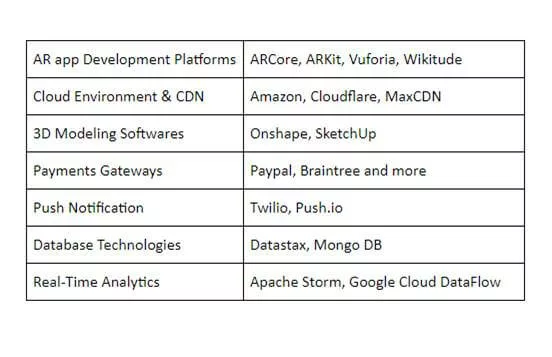
Well, that’s it! We included all the necessary details that you need to know before implementing augmented reality in fashion.
The market of augmented reality for fashion is evolving rapidly and providing new opportunities. You can use this technology in various ways to increase revenue and boost customer experience. With all the capabilities like visualization, deep engagement, and improving the decision-making process, AR is proving to be a useful tool to increase sales, and it is worth considering while creating an app for your brand.
Our team is out there to transform your idea into a fully-functional one that might be a game-changer for your business.
All product and company names are trademarks™, registered® or copyright© trademarks of their respective holders. Use of them does not imply any affiliation with or endorsement by them.

.NET
198
By Devik Gondaliya
15 Jul, 2025

.NET
190
By Devik Gondaliya
15 Jul, 2025

Odoo
249
By Biztech
15 Jul, 2025